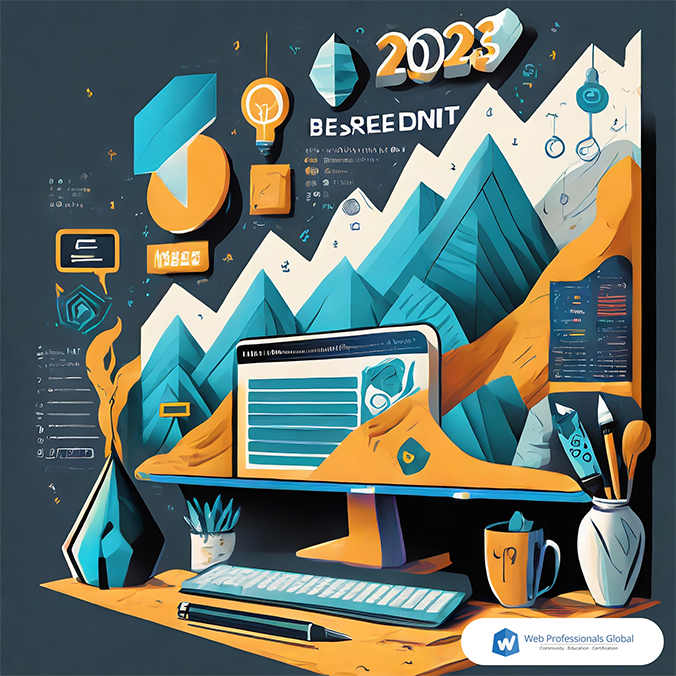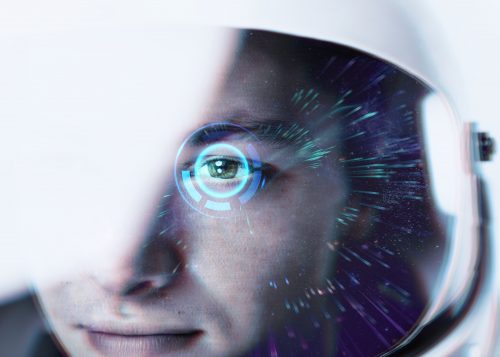
by Mark | Mar 31, 2024 | AI and Machine Learning, CSS3, HTML5, JavaScript, State of the Web, Web Accessibility, Web Security, WWW Desktop View
Spring is officially here (in the northern hemisphere). A lot has been happening both in the organization and the world of web technologies. Readers of this blog know we are in the midst of helping many states with their SkillsUSA web design and development competitions. Winners at the state level are then eligible to compete at the national level in June (in Atlanta). We are glad to be helping these states.
For those who suspect, the featured image was created with AI (Adobe Firefly in this case). Readers of this blog will also recall that all links will open in a new browser tab.
Web Technology Updates
- Accessibility trends – we found this overview of 7 accessibility trends to watch in 2024 an interesting read. Web accessibility testing will become more automated with greater reliance on AI (Artificial Intelligence). Personalized accessibility solutions and more integration of voice technology also top the list. We encourage you to review the article to learn more about these trends.
- CSS – Chris Coyier created a bookmarkable guide to a list of recent enhancements to CSS. We like the overview of these along with notes about when you should care and what browsers support these capabilities now. Working examples (which allow you to also view the code) are highly useful and helpful. Emphasis is on container queries, the :has( ) pseudo selector, View transitions, anchor positioning, and much more. We encourage readers to review and reference his article.
- Frontend Trends – Diego Petrecolla provided a solid overview of frontend trends for early 2024. This includes a nice overview of BFF (Backend for the Frontend) patterns, PWA (Progressive Web Apps), JavaScript and more.
- Web Development Trends – We found this informative article useful as it combines an overview of where these technologies came from (HTML, CSS, JavaScript) along with where they are going (use of AI in web development, voice search optimization, Web Assembly, and cyber security measures). Definitely a lot to think about as we move into the second quarter of 2024.
- Web Design Trends – Christopher Lara reviews 24 web design trends (since it is 2024, after all). From scrolling animations to claymorphism to dark mode to frosted glass effects to voice activated interface, there is a lot to unpack in this article.
- Cybersecurity trends of 2024 – Vera Cooper (Splashtop) provides an overview of many cybersecurity trends which are emerging in 2024. AI and machine learning top her list. IoT is a close second. Phishing attacks, mobile security, and much more are discussed in her article as well.
These are some of the articles/ trends we are watching evolve in 2024. What additional trends do you see? Let us know in the comments. We always look forward to insights from our members.

by Mark | Dec 18, 2023 | Industry News, State of the Web, Web Pro News, Web Professional Trends
As we look back at the digital landscape of 2023, the world of web design and development continues to evolve at a rapid pace, ushering in a new era of innovation and creativity. The team at Web Professionals Global has been fortunate enough to see many of these changes up close. This year, designers and developers have pushed boundaries and redefined user experiences. In this article, we’ll explore the trends that have dominated the web design and development scene in 2023.
As a member, you have access to specific links with all thee articles (providing much more detail). Members should view this linked page for access to all those details. If you are not a member, you will be directed to the join page (members should login first).
Immersive and Interactive Experiences
Web designers are increasingly focusing on creating immersive and interactive experiences to captivate users. With advancements in WebGL and 3D graphics, websites are now offering dynamic and engaging content. From interactive storytelling to product showcases, the web is becoming a more interactive and visually stunning space.
Augmented Reality (AR) Integration
The integration of augmented reality into web design has gained momentum in 2023. AR elements enhance user engagement by overlaying digital information onto the real world. From virtual try-on experiences for e-commerce to interactive educational content, AR is reshaping how users interact with websites.
Dark Mode Dominance
Dark mode has transcended from a trend to a design standard. Offering a sleek and modern aesthetic, dark mode not only reduces eye strain but also conserves device battery life. Major websites and applications are embracing dark mode as a default or optional theme, providing users with a more personalized browsing experience.
Voice User Interface (VUI) Implementation
Voice technology has become more sophisticated, leading to the integration of voice user interfaces in web design. Websites are adopting voice search, commands, and navigation, making it more convenient for users to interact with content hands-free. This trend reflects the growing importance of accessibility and user-friendly interfaces.
Minimalistic and Functional Design
Minimalism continues to be a key design philosophy, with a focus on simplicity and functionality. Clean layouts, ample white space, and intuitive navigation are essential components of modern web design. Striking the right balance between aesthetics and usability, designers are creating seamless and clutter-free digital experiences.
AI-Powered Personalization
Artificial intelligence is playing a pivotal role in web development by enabling personalized user experiences. AI algorithms analyze user behavior and preferences to deliver tailored content, recommendations, and even dynamic website layouts. This level of personalization enhances user engagement and satisfaction.
Blockchain Integration for Security
With an increasing emphasis on cybersecurity, blockchain technology is making its mark in web development. Blockchain provides enhanced security and transparency, making it a valuable addition to websites dealing with sensitive data. This trend is particularly prevalent in e-commerce, finance, and healthcare sectors.
Progressive Web Apps (PWAs)
Progressive Web Apps continue to gain popularity due to their ability to provide a seamless user experience across devices. Combining the best of web and mobile applications, PWAs offer faster load times, offline functionality, and push notifications, enhancing user engagement and retention.
Wrap-Up
In the ever-evolving landscape of web design and development, 2023 has been a year marked by innovation, user-centric experiences, and the integration of advanced technologies. From immersive designs and augmented reality to the widespread adoption of dark mode and AI-driven personalization, these trends collectively shape the digital experiences of users worldwide. At Web Professionals Global,we are excited to continue supporting web professionals around the world and see where the industry goes in 2024. Reach out to us today to find out more about our mission of “Community, Education, Certification.”
If you want more details about any of the above information, please view this linked page (members only – be sure to login first).

by Steve Waddell | May 24, 2022 | State of the Web, Web Design Trends
Mark DuBois, Executive Director of the Web Professionals Organization, shares his thoughts on the next 25 years of the world of the web and technology trends. Mark was asked to take over the organization in April 2016 and has been running it ever since as Executive Director. Click here for Mark’s reflections on the first 25 years of the organization.
I will be the first to say that trying to predict the future of what technology trends and the web will look like is difficult. So take all of this with a grain of salt. These are all my opinions based on 30+ years experience on this stuff. I will start by saying that the web is about documents. When I say document, I don’t mean text-based materials. I use the word document to refer to a package of knowledge—in other words, an association of images, words, videos, sounds that come together as an element of knowing or understanding.
We will always need packages of knowledge from the past to inform how we behave in the present and future. If you don’t know how to build a fire, it would be handy to have a “document” informing you how to do so. And there will be a continued need to access documents in whatever form they may be in.
When Tim Berners-Lee created the first Hypertext Markup Language prototypes, what did he try to do? His focus was on making information available to anyone on any device at any time. In my way of thinking, that’s where the mission remains today. When I started working with web technologies in 1992, there was no CSS, no formatting of text (except by the browser), and no behaviors like JavaScript. There will probably be other stuff that we haven’t even thought about that will happen in the next 25. We will remain focused on the fact that we’re dealing with documents—we will need to archive them and make sure they are available. We will try to meet that original requirement for people to access documents on any device, at any time.

With the web, ideas can cross generations. You can access websites and content on your phone, tablet, Chromebook, laptop, and desktop—you name it. There are all sorts of different ways, but to me, documents are the key. And I think if we focus on documents, there is always going to be a need for archival retrieval of documents. In my mind, that’s the core purpose of the web.
In the next 25 years, there is probably going to be a much greater need for document retrieval—and not just here on Earth. Whether we have some kind of colony on the moon or Mars or more space stations floating around, we will still have documents and need ways to retrieve them. And given the distance that could be involved, retrieval is not going to be instantaneous. Your tweet could take up to 10 minutes to get somewhere—and things may have changed by then, right? The point is that there will still be a great need for web professionals—in the next 25 years and beyond.
Additionally, in the next 25 years, it is possible that 100% of planet Earth will have internet access thanks to technology like SpaceX’s Starlink. Anyone with an internet-connected device will be able to create and consume content, even with an inexpensive internet-connected phone. We are already seeing in real-time the impact of this, as Ukraine has benefited from Starlink satellites.
Remote working will also continue to play a massive role in the global economy. Because of this interconnectedness, it will continue to be easier than ever before to work with people around the world. Over the past several years, a lot of companies and organizations have figured out that employees don’t actually need to be together in a physical office. They are saving tons of money by not paying for office space, utilities and more. And employees are usually happier working remotely. They can spend more time with their children and less time sitting in traffic traveling to and from work. The whole nature of work is changing, and we’re never going back to the way it was.
We’re past the revolution phase, where we have a world wide web and so forth. We’re now into the evolution phase, where it’s just going to keep growing. As much as I hate to use the term, the next version will be Web 3.0. However, even as things improve, we’re going to take a step back for every two steps forward. For example, look at blockchain—it’s like we’ve taken a big step backwards in terms of robust user interfaces and accessible interfaces. But that’s going to happen repeatedly, as things evolve over time and new technology trends emerge.

One of my big passions has always been security. And we keep making the same security mistakes that we have in the past, which must change. Security is so important because of the vast amount of data that is being created each and every day. And this data is gold to those who wish to get their hands on it. The information that’s in your documents needs to be reliable and secure. And combatting things like deep fakes in the coming years will be increasingly difficult and require entirely new tools and approaches. In the coming years, two-factor authentication will not be powerful enough to protect highly sensitive information.
Another interest of mine is accessibility, which I think is going to remain a big issue and one of the most important technology trends. Although interfaces are improving, they’re not there yet. For example, Apple’s Siri feature often resembles a drunk elf when you try to dictate something to her. So those areas still need improvement in the coming years.
It used to be that you had a little bit of knowledge. And you could make a career in a corporation, because you were a keeper of that knowledge. Today, the best way to make a career is to be the one who is able to curate the content and distribute the knowledge to others. Keeping information secure and accessible is a big part of this.
The whole merging of artificial intelligence with documents is going to require things like blockchain, to make sure that information is valid. The whole point behind blockchain is that you’ve got an audit trail—and that audit trail cannot be changed. And if you apply it in terms of documents, to me, that’s a way of dealing with some of this AI-generated deep fake stuff that I guarantee is out there.
We Support Web Professionals in Adapting to Technology Trends
Part of our mission is to continue to develop and support a thriving professional community who are connected to the internet and prepared to meet the next technology trends. We take a big-picture look to make sure this community remains vibrant and sustainable to reach the next level and help others for years to come. We will continue to work with students, teachers, and working professionals to meet their needs. In the web industry, you need to know how to run a business, bring value to clients, and execute on your promises. We are preparing current and future generations to do just that. As we mentioned in the article about the past 25 years, our mantra continues to be “Community, Education, Certification.”
To be frank, we don’t know where this is all going. We have always made our certifications good for two years because of how fast the industry changes. We at the Web Professionals Organization are in it for the long haul. We will continue to evolve and adapt to whatever the web industry will look like next year, in five years, and in 25 years. Many associations that began around the time we were founded are no longer around. We are okay making mistakes and being wrong about the future—but we will always adapt. We look forward to what the next 25 years hold for the web industry. If you are reading this and would like to be a part of tomorrow’s technology trends, reach out to us today.

by Mark | Jul 1, 2021 | Cyber Crime, Industry News, State of the Web, Web Security
This month, I thought it appropriate to post some of my thoughts concerning web and security. Unless you have been unconscious for a while, you have seen so many news articles about ransomware attacks on various corporations. Since many readers work with clients (both internal and external), here are some of my thoughts regarding security. The sad thing is that most of these attack vectors are nothing new. They have been employed for some time, yet some people still fall victim.
I am focusing on what you can do as an individual. Obviously, this is a very large topic and I am just touching on some of the highlights as I see them. I look forward to your comments and encourage further discussion in our member Slack channels where we can focus on more specific items).
Passwords
- Passwords should be long and complex. If in doubt, length wins over complexity. Consider using passphrases.
- Passwords should be changed on a regular basis. You decide on what is comfortable for you.
- Passwords should never be reused on more than one site. Never. There is no reason why you need to do this.
- If you can’t recall passwords, use a password vault. There are a number of alternatives. Just make certain it is secure and your passwords are updated in the vault as you change them.
- Passwords should never be shared with others. Never. If there is some unusual situation where another must access your information, change your password, give that party the new one, then change the password again once the need for their access has passed. Frankly, I can not think of any situation where this is warranted, but…
email
- Never open links included in email messages. If you receive a link to a website (such as a banking site), open a browser and type the URL. It is so easy to spoof website addresses these days. That is why you should manually enter any site URL where you are required to authenticate.
- Unless you are expecting an attachment from someone, never open email attachments. Never. This is where most malware gets started. I recommend using some form of online storage (which is virus checked) if you must share documents these days.
2FA
- Whenever possible employ two factor authentication as part of your login. In a nutshell, there are three ways to prove you are who you say you are – something you know (like a password), something you posess (like an authentication app), and something you are (like facial recognition or fingerprints). I recommend using the first two in combination since it is very difficult to change your bio-metrics.
Phone calls
- I recommend activating the feature found on modern mobile devices which only allow for incoming calls from those in your list of contacts. Anyone else must leave a voice message. Most scammers rely on a sense of urgency to get you to take an action you would typically not do (for example, say “yes” or share a password. Review the voice message and only call back if you are certain you need to speak with the individual leaving the message. Most scammers will likely not even leave a voice message. I assure you, the sheriff’s department will never call you to let you know they are coming to arrest you. It is best to delete similar junk.
Final thoughts
I know this list is not complete, and should be obvious to readers. However, it never hurts to review the basics periodically. Always apply a healthy dose of skepticism when anyone contacts you and asks you to take action. The more immediate their request, the greater the likelihood it is a scam.
by Mark | May 1, 2021 | Industry News, State of the Web, Web Accessibility, Web Content, Web Professional Trends
Note from Mark. I plan to periodically provide article summaries and insights. I am hoping this will happen once each month. Hope is the operative word. Here are my thoughts as we begin May, 2021. I welcome your comments about additional topics you would find helpful as well as your thoughts about these articles. I found them most interesting/ thought provoking.
Accessibility
Using Modern CSS to Improve Accessibility. This article by Stephanie Eckles provides a quick overview of what it means to have an accessible website. Stephanie then covers using some of the newer CSS to enhance accessibility. This includes use of outline-offset to position the outline away from the element. The focus-visible pseudo-class will display an outline only when the user agent determines it needs to be visible. There is so much more in this article, I encourage you to set aside time to read it in its entirety and digest how these CSS features can be used to solve real world accessibility issues.
A.I.
GPT-3 is a language supermodel which is quietly ushering in the A.I. revolution. This article by Luke Dormehl explains why this text generating algorithm makes a difference. The main difference with prior algorithms is that limited training is required. In the past, significant input was required for A.I. to “learn.” This no longer seems to be needed. Think. About. That. Here is a key quote from the article (it certainly resonated with me).
“Machine learning has been transformative in all sorts of ways over the past couple of decades. But machine learning requires a large number of training examples to be able to output correct answers. GPT-3, on the other hand, has a “few shot ability” that allows it to be taught to do something with only a small handful of examples.”
Ok, Mark, what does all this A.I. have to do with Web design and development? One example mentioned in the article is a layout generator which”renders a functional layout by generating JavaScript code from a simple text description.” Another example is a GPT-3 based search engine. I think you will find this article most interesting and informative. Our industry is changing and A.I. is going to have a major impact. Plan accordingly.
FLoC
Federated Learning of Cohorts is Google’s replacement for tracking cookies. Our advisory board member, Deborah Edwards-Orono, has a great article about this effort and her concerns. Simply put, FLoc is included by default in the new version of the Chrome browser [see our recent post on the popularity of this browser] and collects your recent browser activity. It takes that activity and labels it then shares the “cohort” with other websites and advertisers. The main concern with this approach is privacy. She also discusses a new WordPress plugin Disable FLoC which is easy to install and has no configuration settings, it just does what it claims to do. If you would like to learn more about the implications of FLoC, the Electronic Frontier Foundation has a solid overview as well.
For those not using WordPress, Marko Saric has an overview article at Plausible which also includes the snippet of code you can add to your .htaccess file to disable FLoC as well.
Future of the WWW
Professor Sir Tim Berners’Lee (inventor ot the WWW) thinks his creation is out of control. In this interview, he explains his plans to save it.The big issue these days is privacy. He proposes Solid (a new system to decentralize the Web). His core idea is PODS (Personal Online Data Stores) which each person has control over. The fundamental change is that anyone wanting to use your information must ask for your permission. After you review the interview, I would be keen to learn your thoughts about this approach. Comments are open.
Hardware
Gizmodo recently discussed the fact that Verizon is recalling 2.5 million of its hotspots because they are literally too hot. There have been 15 reports of the devices overheating (6 instances of fire damage). Review the article to see if you have one of these hotspots (various models sold between April, 2017 and March, 2021).
WordPress
Easy WP Guide has been released for WordPress 5.7 (most current version). No discussion of PHP or the technical details, just a comprehensive guide to help you edit the content of your site. This is a free download. Web Professionals who build sites using this technology may wish to share this document with their clients (if you haven’t already). You can purchase the guide which allows you to brand it as you wish.
For those developers using Elementor as part of their WordPress installations, you may wish to review the recent Wordfence post discussing recent vulnerabilities with Elementor. For those who are not aware, Elementor is installed on over 3.5 million WordPress sites. The Wordfence team found over 100 vulnerable endpoints.
Final thoughts
Hopefully, you found these articles and insights helpful. What else would you like to see in future articles? What did you think about these? I look forward to reading your comments.
Best always,
Mark DuBois, Executive Director
Web Professionals (a.k.a. World Organization of Webmasters)

by Steve Waddell | Apr 11, 2021 | Industry News, State of the Web, Web Development
Three months into 2021, there are several web development trends that have clearly emerged. The digital market is competitive, and it’s important for developers to stay abreast of the latest trends impacting the industry. Let’s take a look at the trends that all web professionals should be aware of in order to stay ahead of the competition through the rest of 2021.
Artificial Intelligence and Bots
AI and bots continue to be used more than ever before by developers. Their ability to collect data, learn about users, and solve issues with human intervention make them highly attractive for companies seeking to streamline operations and customer service. Today’s consumers expect 24/7 service, and AI can deliver just that for companies seeking to maintain their engagement with customers while saving money. AI and bots can be incorporated into sites and mobile apps for a wide variety of devices. Staying on top of the latest in AI and bots can give your company a leg up on the competition.
Voice Search Optimization
Today, many internet users access web services without typing or even looking at the screen of a device. People can control garage doors, lights, security systems, thermostats and much more just by talking to a smart device in their home. It’s clear that voice recognition will continue to be an important aspect of web development for years to come, and it is estimated that as many as 50% of households with internet access will utilize a voice assistant by the end of 2022. Companies are in need of developers who can create web services that are accessed by voice command.
Accelerated Mobile Pages (AMP)
The primary idea behind this technology is to speed up page performance to keep the user engaged with the mobile site and reduce the chance that the user leaves before the site page loads. Essentially, AMPs are optimized pages with a simplified and scaled-down design. This allows the pages to load quickly while only displaying basic features. They have easy-to-read content and are formatted to work seamlessly with smartphones and tablets. AMPs level the playing field for users, as even people with slower internet speeds can access and enjoy AMP features.
Automation Testing
This helps developers test their products more effectively than the traditional manual testing. Put simply, web development is judged by how fast and efficient it is for the use. Automation testing promotes better testing coverage, makes the development process cheaper and reduces the time of the test cycle, allowing smaller web development companies to compete with those with more resources. This form of testing also creates a better user experience and allows developers to more quickly and efficiently identify issues.
App Accessibility
This trend is about making web applications more accessible for consumers, organizations and businesses. Single-Page Applications (SPAs) are on the rise, as they don’t require users to reload the page while using it. An example of a platform that uses SPAs is Facebook. As users scroll down, new content appears automatically. Another growing trend is the use of Progressive Web Applications (PWAs), which offer stripped-down versions of native applications with the benefit of not requiring the user to download a new app. PWAs are cost-effective and can deliver users an easy experience.
These are a handful of the trends that will drive web development through the rest of 2021 and beyond. As a web professional, stay on top of what is going on in the industry so you can stay a step ahead of the competition.







